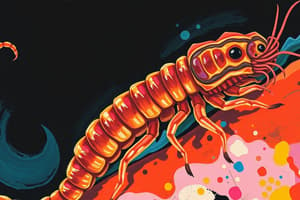Podcast
Questions and Answers
What is Strongylida?
What is Strongylida?
A large group of major parasitological significance known as 'strongyles' or bursate nematodes.
Which of the following are types of Ancylostoma?
Which of the following are types of Ancylostoma?
- Ancylostoma caninum
- Ancylostoma ceylanicum
- Ancylostoma braziliense
- All of the above (correct)
Are Ancylostoma worms contagious for humans?
Are Ancylostoma worms contagious for humans?
True (A)
What is the main pathological effect of Ancylostoma?
What is the main pathological effect of Ancylostoma?
The eggs of Strongylida are thin-shelled, oval and _____ when passed out.
The eggs of Strongylida are thin-shelled, oval and _____ when passed out.
What are the infective stages of hookworms?
What are the infective stages of hookworms?
What is the approximate length of male and female Strongylida?
What is the approximate length of male and female Strongylida?
How do L3 larvae enter the host?
How do L3 larvae enter the host?
What is the role of L1 and L2 in the life cycle of Strongylida?
What is the role of L1 and L2 in the life cycle of Strongylida?
Match the following species with their affected hosts:
Match the following species with their affected hosts:
Flashcards
Strongylida
Strongylida
A large group of parasitic nematodes (roundworms) of significant veterinary importance.
Morphology (Strongylida)
Morphology (Strongylida)
Strongyles have a characteristic morphology: adults range in length from 0.5 to 3.0 cm, possess a copulatory bursa & leaf-like structures at the anterior end.
Ancylostoma spp.
Ancylostoma spp.
Hookworms affecting dogs/cats (and humans). Characterized by a large buccal capsule and teeth, causing anemia.
Strongylus vulgaris
Strongylus vulgaris
Signup and view all the flashcards
Syngamus trachea
Syngamus trachea
Signup and view all the flashcards
Strongyle Life Cycle (general)
Strongyle Life Cycle (general)
Signup and view all the flashcards
Hookworm Infection (human)
Hookworm Infection (human)
Signup and view all the flashcards
Infective Stage (Strongyles)
Infective Stage (Strongyles)
Signup and view all the flashcards
Hepatic-Tracheal Migration
Hepatic-Tracheal Migration
Signup and view all the flashcards
Larval Stages (Strongyles)
Larval Stages (Strongyles)
Signup and view all the flashcards
Study Notes
Strongylida
- Strongylida, also known as 'strongyles', are a large group of parasitic nematodes.
- They are of significant parasitological importance.
Morphology
- Strongyles are typically 0.5-3.0cm long (males ~1cm, females ~2cm).
- Males have a copulatory bursa (fan-like structure strengthened by chitinous rods) at the posterior end.
- Leaf crowns may be present at the anterior end.
- Eggs are thin-shelled, oval, and unembryonated when passed out.
Life Cycle
- Life cycle can be direct or indirect.
- Some strongyles (e.g., Ancylostoma) penetrate the skin, leading to hepatic-tracheal migration.
- Others (e.g., other strongyles) use the oral route.
- L3 (third-stage larvae) are the infective stage.
- L1 and L2 feed on materials in feces.
- L3 do not feed and depend on food granules accumulated during L1 and L2 phases.
- L3 can be found in soil and grasses.
- L3 gains entry into the host through ingestion.
Ancylostoma spp.
- Includes Ancylostoma caninum, Ancylostoma ceylanicum, and Ancylostoma braziliense, affecting cats and dogs.
- Commonly known as hookworms due to the hook-like posture of the anterior ends.
- Possess large buccal capsules with teeth.
- Their primary pathological consequence is blood sucking, leading to acute or chronic hemorrhagic anemia (in larvae and adult worms).
- Dogs and cats infected with Ancylostoma can transmit the infection to humans via contact with contaminated soil.
Strongylus vulgaris
- A strongyle affecting horses.
- Characterized by a leaf crown surrounding the mouth opening and a large buccal capsule with two rounded teeth.
- Larvae migrate on the endothelium, causing arteritis, thrombosis, and infarction in the intestines.
- Resultant damage and inflammation cause colic.
- Adult worms are tissue feeders in the cecum and colon, leading to hemorrhage.
Syngamus trachea
- A tracheal worm affecting poultry.
- Male and female worms are permanently joined in a Y-shape.
- Can act as paratenic hosts (earthworms are an example).
- Cause haemorrhagic tracheitis, characterized by excess mucous production.
Routes of Infection
- Skin penetration by L3: L3 stage larvae penetrating the skin then undergoing tracheal migration.
- Ingestion of L3: L3 larvae are ingested.
- Transmammary infection: L3 can be passed in milk.
General Notes:
- The time of larvation of eggs depend on factors like temperature, oxygen density, and humidity.
Studying That Suits You
Use AI to generate personalized quizzes and flashcards to suit your learning preferences.



